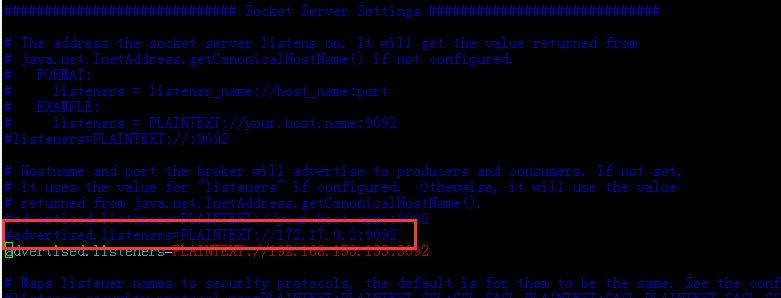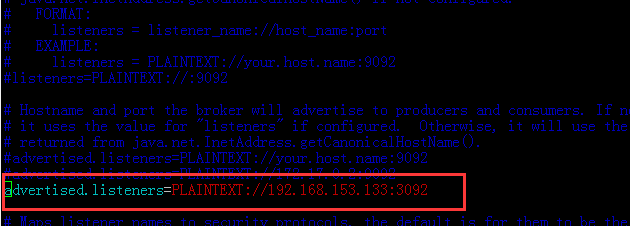docker kafka 外网访问不到
linux虚拟机中的kafka docker 容器外网显示:

原因:
kafka的外网IP端口配置参数设置错误。
原--》设置了容器的IP端口。

改--》设置宿主机的ip以及宿主机上的端口。


摘取:
Kafka跨网络访问设置
- kafka应用通过docker进行部署并暴露出不同kafka节点到不同的指定端口;
- 业务系统通过虚拟机进行部署;
- docker宿主机与业务系统在同一个局域网;
- 业务系统连接kafka时返回docker kafka服务名及原端口(9092)
- can not found the leader of kafka
原因:
- kafka配置文件server.properties中,host.name只绑定在了内部的IP上面,对外的网卡无法访问,及在物理业务系统服务器上面并不能识别到kafka服务名;
- 把值设置为空的话会kafka监听端口在所有的网卡上绑定。但是在外网访问时,客户端又遇到了“java.nio.channels.ClosedChannelException”异常信息,server端用tcpdump分析的时候发现客户端有传递kafka所在容器的服务名过来。在client里断点跟踪一下发现是findLeader的时候返回的元信息是容器服务名而不是IP。业务系统客户端无法解析这个机器名所以出现了前面的异常。
参考文章:
Kafka跨网络访问设置
配置文件的内容:
# Licensed to the Apache Software Foundation (ASF) under one or more
# contributor license agreements. See the NOTICE file distributed with
# this work for additional information regarding copyright ownership.
# The ASF licenses this file to You under the Apache License, Version 2.0
# (the "License"); you may not use this file except in compliance with
# the License. You may obtain a copy of the License at
#
# http://www.apache.org/licenses/LICENSE-2.0
#
# Unless required by applicable law or agreed to in writing, software
# distributed under the License is distributed on an "AS IS" BASIS,
# WITHOUT WARRANTIES OR CONDITIONS OF ANY KIND, either express or implied.
# See the License for the specific language governing permissions and
# limitations under the License.
# see kafka.server.KafkaConfig for additional details and defaults
############################# Server Basics #############################
# The id of the broker. This must be set to a unique integer for each broker.
broker.id=0
# add my config kongfanjun
#port=9092
#端口号
#host.name=127.0.0.1
#服务器IP地址,修改为自己的服务器IP
log.dirs=/usr/local/kafka_2.11-1.1.0/logs
#日志存放路径,上面创建的目录
zookeeper.connect=localhost:2181
#zookeeper地址和端口,单机配置部署,localhost:2181
############################# Socket Server Settings #############################
# The address the socket server listens on. It will get the value returned from
# java.net.InetAddress.getCanonicalHostName() if not configured.
# FORMAT:
# listeners = listener_name://host_name:port
# EXAMPLE:
# listeners = PLAINTEXT://your.host.name:9092
#listeners=PLAINTEXT://:9092
# Hostname and port the broker will advertise to producers and consumers. If not set,
# it uses the value for "listeners" if configured. Otherwise, it will use the value
# returned from java.net.InetAddress.getCanonicalHostName().
advertised.listeners=PLAINTEXT://192.168.153.133:3092
# Maps listener names to security protocols, the default is for them to be the same. See the config documentation for more details
#listener.security.protocol.map=PLAINTEXT:PLAINTEXT,SSL:SSL,SASL_PLAINTEXT:SASL_PLAINTEXT,SASL_SSL:SASL_SSL
# The number of threads that the server uses for receiving requests from the network and sending responses to the network
num.network.threads=3
# The number of threads that the server uses for processing requests, which may include disk I/O
num.io.threads=8
# The send buffer (SO_SNDBUF) used by the socket server
socket.send.buffer.bytes=102400
# The receive buffer (SO_RCVBUF) used by the socket server
socket.receive.buffer.bytes=102400
# The maximum size of a request that the socket server will accept (protection against OOM)
socket.request.max.bytes=104857600
############################# Log Basics #############################
# A comma separated list of directories under which to store log files
#log.dirs=/tmp/kafka-logs
# The default number of log partitions per topic. More partitions allow greater
# parallelism for consumption, but this will also result in more files across
# the brokers.
num.partitions=1
# The number of threads per data directory to be used for log recovery at startup and flushing at shutdown.
# This value is recommended to be increased for installations with data dirs located in RAID array.
num.recovery.threads.per.data.dir=1
############################# Internal Topic Settings #############################
# The replication factor for the group metadata internal topics "__consumer_offsets" and "__transaction_state"
# For anything other than development testing, a value greater than 1 is recommended for to ensure availability such as 3.
offsets.topic.replication.factor=1
transaction.state.log.replication.factor=1
transaction.state.log.min.isr=1
############################# Log Flush Policy #############################
# Messages are immediately written to the filesystem but by default we only fsync() to sync
# the OS cache lazily. The following configurations control the flush of data to disk.
# There are a few important trade-offs here:
# 1. Durability: Unflushed data may be lost if you are not using replication.
# 2. Latency: Very large flush intervals may lead to latency spikes when the flush does occur as there will be a lot of data to flush.
# 3. Throughput: The flush is generally the most expensive operation, and a small flush interval may lead to excessive seeks.
# The settings below allow one to configure the flush policy to flush data after a period of time or
# every N messages (or both). This can be done globally and overridden on a per-topic basis.
# The number of messages to accept before forcing a flush of data to disk
#log.flush.interval.messages=10000
# The maximum amount of time a message can sit in a log before we force a flush
#log.flush.interval.ms=1000
############################# Log Retention Policy #############################
# The following configurations control the disposal of log segments. The policy can
# be set to delete segments after a period of time, or after a given size has accumulated.
# A segment will be deleted whenever *either* of these criteria are met. Deletion always happens
# from the end of the log.
# The minimum age of a log file to be eligible for deletion due to age
log.retention.hours=168
# A size-based retention policy for logs. Segments are pruned from the log unless the remaining
# segments drop below log.retention.bytes. Functions independently of log.retention.hours.
#log.retention.bytes=1073741824
# The maximum size of a log segment file. When this size is reached a new log segment will be created.
log.segment.bytes=1073741824
# The interval at which log segments are checked to see if they can be deleted according
# to the retention policies
log.retention.check.interval.ms=300000
############################# Zookeeper #############################
# Zookeeper connection string (see zookeeper docs for details).
# This is a comma separated host:port pairs, each corresponding to a zk
# server. e.g. "127.0.0.1:3000,127.0.0.1:3001,127.0.0.1:3002".
# You can also append an optional chroot string to the urls to specify the
# root directory for all kafka znodes.
zookeeper.connect=localhost:2181
# Timeout in ms for connecting to zookeeper
zookeeper.connection.timeout.ms=6000
############################# Group Coordinator Settings #############################
# The following configuration specifies the time, in milliseconds, that the GroupCoordinator will delay the initial consumer rebalance.
# The rebalance will be further delayed by the value of group.initial.rebalance.delay.ms as new members join the group, up to a maximum of max.poll.interval.ms.
# The default value for this is 3 seconds.
# We override this to 0 here as it makes for a better out-of-the-box experience for development and testing.
# However, in production environments the default value of 3 seconds is more suitable as this will help to avoid unnecessary, and potentially expensive, rebalances during application startup.
group.initial.rebalance.delay.ms=0
docker kafka 外网访问不到的更多相关文章
- 外网访问内网Docker容器
外网访问内网Docker容器 本地安装了Docker容器,只能在局域网内访问,怎样从外网也能访问本地Docker容器? 本文将介绍具体的实现步骤. 1. 准备工作 1.1 安装并启动Docker容器 ...
- kafka的advertised.host.name参数 外网访问配置
kafka的server.properties文件 ```host.name```开始只绑定在了内部IP上,对外网卡无法访问. 把值设置为空的话会kafka监听端口在所有的网卡上绑定.但是在外网访问时 ...
- Kafka集群无法外网访问问题解决攻略
Kafka无法集群外网访问问题解决方法 讲解本地消费者和生产者无法使用远程Kafka服务器的处理办法 服务搭建好Kafka服务后,机本.测试 OK,外面机器却无法访问,很是怪异. 环境说明: Ka ...
- docker安装redis并允许外网访问
拉取redis镜像 docker pull redis:3.2 本地新建redis配置文件 redis.conf ,写入以下内容 #允许外网访问bind 0.0.0.0 daemonize NO pr ...
- ubuntu下安装mysql及外网访问设置
这么多年一直是mssql或者Oracle,mysql基本没用过,借着.net即将跨平台之际,也mysql一把.windows安装基本没啥难度,然后就是试了把linux下...结果坑不少,由于linux ...
- Kafka内外网访问
本文介绍了Kafka内外网访问的设置. kafka的两个配置listeners和advertised.listeners listeners kafka监听的网卡的ip,假设你机器上有两张网卡,内网1 ...
- TortoiseSVN和VisualSVN-Server的配置使用,外网访问SVN版本库
TortoiseSVN和VisualSVN-Server的配置使用,外网访问SVN版本库 SVN客户端程序:TortoiseSVN SVN服务器程序:VisualSVN-Server ######## ...
- vs visual studio 让外网访问设置
vs2015 提供外网访问我是这么解决的 有时我们经常会用到连接外网的方式来调试自己写的莫名bug.而我们通常有两种解决方式 一.捕捉错误日志进行代码分析. 二.则是将我们的源码项目提供外网访问进行直 ...
- svn设置外网访问
1.设置路由器 默认协议为:https 端口号:443 服务器地址:https://主机名/svn/版本库 例:https://mleo-pc/svn/Share/ 也可就主机名用IP地址代替 如:h ...
随机推荐
- linux centos7最小化安装桥接模式网络设置、xshell、xftf
一.网络连接设置1.桥接模式 使用电脑真实网卡,可以和自己的电脑连接,也可以和外部网络连接2.NAT模式 使用wmware network adapter vmnet8虚拟网卡,可以和自己的电脑连接, ...
- git bash 出现vim弹框的时候怎么退出
如果是输出状态,首先按Esc键退出输入状态,然后按Shift+“;”,再输入q!或wq!(不保存改动,wq!是保存文件的写入修改)退出. so easy!!
- web assembly是什么,能干什么
web assembly混合javascript和另外底层语言编译的模块,共同运行.将js的高级,易用及c/c++的高效底层优势结合起来. 最可能的用处是提供一种可行的方法将原来的c/c++应用por ...
- npm run dev时报错“events.js:160 throw er; // Unhandled 'error' event”
经查,此问题由端口占用导致,node服务器默认端口8080已被其他程序占用,关闭占用端口的程序或者修改node服务器的默认端口即可解决此问题
- python升级 (2.6升级到3.5)
在引用模块pandas时竟然提示不支持2.6, 果断升级,在网上找了很多博客,觉得这个比较清楚(https://blog.csdn.net/my_bai/article/details/7289602 ...
- qmake
https://blog.csdn.net/m0_37876745/article/details/78537556
- Word、rss、HTML解析等dll
RSS.NET.dll RSS.NET是一款操作RSS feeds的开源.NET类库.它为解析和编写RSS feeds提供了一个可重用的对象模型.它完全兼容RSS 0.90, 0.91, 0.92, ...
- 汉诺塔问题php解决
面向过程解决 <?php function hanio($n,$x,$y,$z){//把n个盘子,按照要求从x移到z,y是中介 //递归跳出条件 if($n==1){ move($n, $x, ...
- python第十七课——列表生成式
1.列表生成式: 什么是列表生成式? 它就是一串表达式,专门用于生成列表对象,当中包含一系列的业务逻辑: 结构:简介.优雅.阅读性好:比传统获取列表对象来的更加的方便: 它是语法糖的一种: 什么是语法 ...
- sql按月模糊查询
select * from tb where convert(varchar(7),date,120) = '2011-05'
